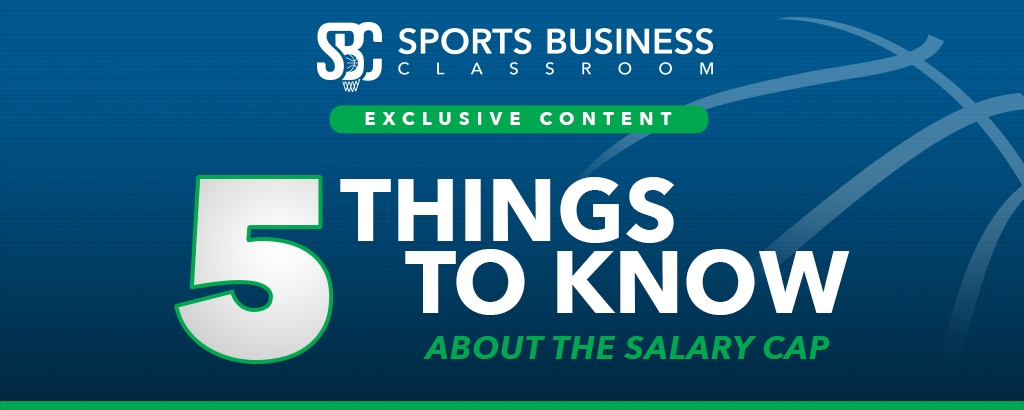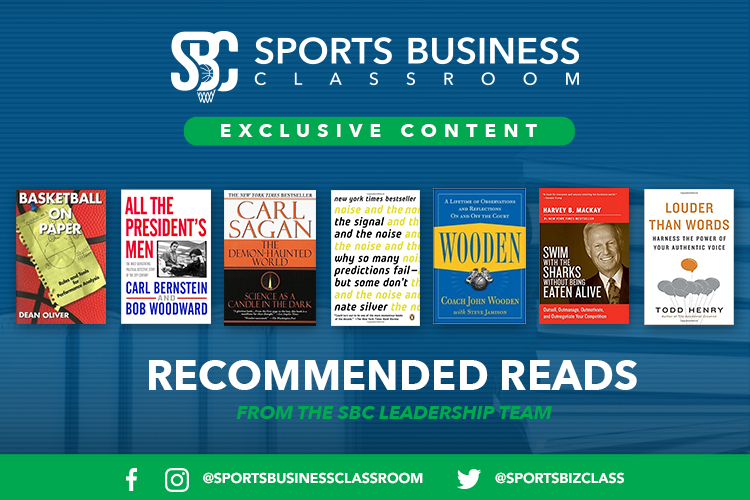by Larry Coon, GM – Sports Business Classroom / Lead – Salary Cap & Executive Session
This is the first in a series of original content written by Sports Business Classroom leads covering important and interesting things to learn before the start of the program. In the “Five things to know” series, we will explore different topics, such as the SBC majors, our fields of expertise, and even the program itself to give you the essentials. In this article, SBC General Manager Larry Coon gives you five things you need to know about the salary cap.
I spoke at the Sloan Sports Analytics conference in Boston this year, presenting some the essential features of the new agreement.
1. Not much changed. Given the contentious labor negotiation in 2011, and the rush to finalize a new agreement in time to start the season on Christmas Day, you’d think they’d have a lot of issues to revisit and re-negotiate this time around. Not so – remarkably, the 2017 agreement has the same fundamental structure as the 2011 agreement. They kept the same 50/50 split of revenues between the players and owners (the most contentious issue in the 2011 lockout). The salary cap and luxury tax structures are essentially unchanged. The salary cap exceptions are the same. They even punted on changing the age limit, putting off any such discussions until later. There are lots of small changes in the new agreement, but the big features are all unchanged.
2. There will be less superstar movement. The new agreement comes in the wake of Kevin Durant leaving Oklahoma City for Golden State to form a super team with Steph Curry, Klay Thompson and Draymond Green. Even though it took a series of fluke circumstances (including two different 3-1 playoff series going the wrong way) to set up Durant’s move to California, the league wanted to further limit superstar movement, because such movement is by and large good for big market teams and bad for medium and small market teams. They did this by implementing the “Designated Veteran” rule, which provides a big incentive for these players to stay with their original teams. Players coming off their rookie extensions (finishing their eighth or ninth seasons in the league) can sign for a higher maximum salary if they meet certain performance criteria, including being named MVP or to an All-NBA team.
In addition to restricting years of service and setting performance criteria, the Designated Veteran rule also limits eligibility to include only players who are still with their original teams – the only exception being that the player can still qualify if he was traded in his first four years in the league. This means that James Harden, who was traded just before the start of his fourth season, is eligible for this rule. It also means that Demarcus Cousins, who was traded just prior to becoming a free agent, is not eligible. By being traded, Cousins lost the ability to earn an extra $30 million in his next contract. Ironically, the first effect of this rule – intended to curtail superstar movement – was the trade of a superstar.
3. There will be a new kind of player. There are NBA players, and there are D-League players. A player signed to an NBA contract can be assigned to his team’s D-League affiliate, but earns a much higher salary and continues to take up a spot on the parent club’s roster. A player signed to a D-League contract earns a much smaller salary and doesn’t take up an NBA roster spot, but he isn’t protected – other NBA teams can poach any player signed to a D-League contract.
The new agreement creates a third type of player, called a Two-Way player, which is a hybrid between an NBA player and D-League player. A Two-Way player earns a higher salary than a regular D-League player, but much less than an NBA player. A Two-Way player can be called-up to the NBA team for up to 45 days during the season, and he earns a full NBA salary for the days he’s with the parent club. A Two-Way player can’t be poached by another NBA team, and NBA teams get two additional roster spots reserved exclusively for Two-Way players.
4. There will be fewer crazy trades: Every year there are a lot of trades that make little sense from a basketball perspective, because these trades were motivated by the players’ contracts rather than their playing ability. This often happened when a player had a large salary, but only a small amount of that salary was guaranteed.
Here’s an example: suppose a player had a $10 million salary, but only $1 million of that was guaranteed. If another team acquired this player in trade, it could send out as much as $15 million of salaries in exchange (likely adding some sweetener such as cash or draft picks to make it more attractive), then simply waive the player after acquiring him. The net effect would be to unload $14 million from the team’s books, with only the $1 million guarantee remaining after the waiver. In this contrived example, this unbalanced trade and waiver nets the team up to $14 million of cap room that could then be used to sign free agents.
A new rule changes the trade math in these sorts of deals. For any contract signed moving forward, the salary matching only pays attention to the player’s guaranteed salary, and not to his total salary. So under this new rule, teams will have a much tougher time unloading salary they don’t want to keep.
Another new rule keeps teams from spending way below the minimum team salary, and then trading for player at the trade deadline. In the past, teams that did this got the player’s full annual salary applied toward their minimum team salary, but only had to pay the player for the last third of the season. A new rule pro-rates the player’s salary for minimum team salary purposes. If the player is traded two-thirds through the season, they only get to claim the last third of his salary on their books.
5. Even more focus on player health and safety: There have been many cases of players who have had an injury or illness which effectively ended their playing careers, but who weren’t ready to hang up their sneakers. Such circumstances can have tragic consequences if a player tries to keep playing despite the best medical advice saying that he shouldn’t risk it.
The new agreement creates “Fitness to Play” panels to evaluate these kinds of situations. If a doctor advises a team that a player should not play, the league or union can refer the player to one of these panels. A Fitness to Play panel consists of three medical doctors who are experts in the condition being evaluated, and who apply the gold standard of medical practice when evaluating the player’s case. If a player is referred to one of these panels, he cannot play until and unless the panel clears him to play.
Of course, no one can force a team to actually play any specific player, so it’s possible for a player to be cleared by a Fitness to Play panel and still not get off the team’s bench. However, a player has recourse under this circumstance – if a Fitness to Play panel clears a player to play, and the team doesn’t play him within 60 days, it must waive him or trade him to another team.



Leave A Comment